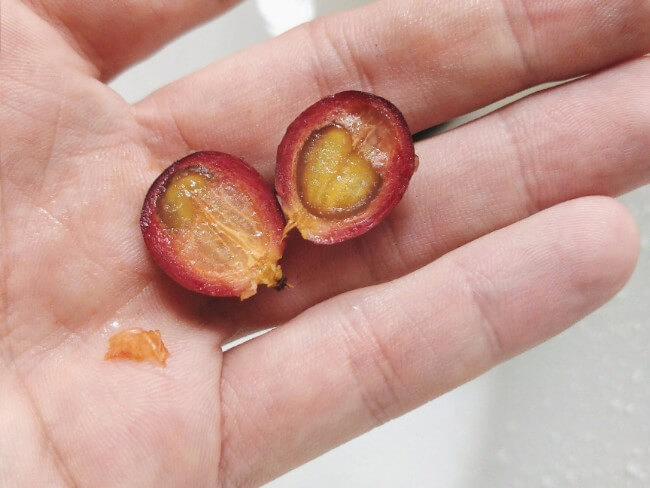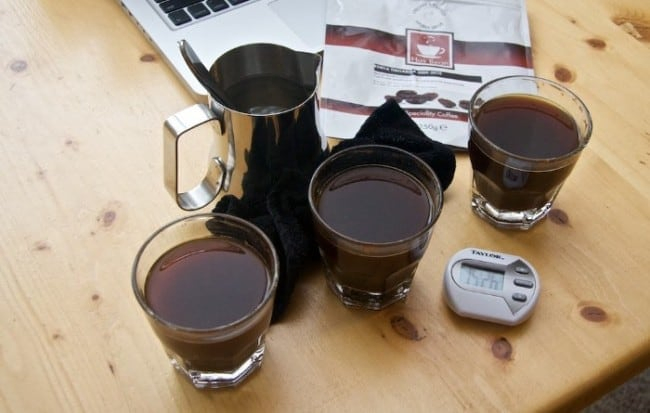Most people surfing the web today have some kind of attention deficit disorder.
So I wrote this post to boil every single thing I have learned about coffee down to something that can be read in the time it takes to prepare (and eat) a cup of instant noodles.
Are you ready to get your career as a home-barista kickstarted?
Then put the fidget spinner down for seven minutes and thirty seconds and read on.
Warning: What you are about to read might change your view of coffee entirely!
This post contains the foundational coffee knowledge that you need to understand and appreciate specialty coffee.
However, because there are so many urban legends when it comes to coffee, you might be rather surprised with some of the information presented here.
Among coffee experts all this is common knowledge; but in the broad population most people have never heard about these concepts.
#1: The cherry trumps everything
You can make great coffee if you have high-quality beans and cheap equipment.
However, you can’t do the reverse.
What this essentially means, is that coffee cherry is way more important than the equipment.
The raw biological potential of the cherry (or bean as it later becomes) is the the most critical factor in coffee.

If the bean is from a good cultivar and grown under the right conditions in fertile soil, it will be sweet and packed with flavors.
Unfortunately, most coffee on the shelves of the supermarket is grown at low altitude in farms lacking biodiversity. Even if you have a $5000 espresso setup, you won’t be able to get a spectacular result with a second rate bean.
Contrary to what many people think, coffee is strikingly similar to gastronomy. The grass-fed organic beef will taste a lot better than the grain fed commercial steak available in a discount supermarket.
Exactly, the same thing applies to coffee; what happens at the farm is the most crucial step towards a delicious cuppa Joe.
Besides, being grown in the right climate by a diligent farmer, the coffee should be from a good Arabica cultivar. If you buy coffee from a respectable roaster, you should be able to see the cultivar/varietal on the bag.
Some of the best coffee cultivars
- Geisha: The World’s most expensive coffee. Outstanding flavor profile.
- Pacamara: A giant variety with a bittersweet acidity and amazing mouthfeel.
- SL 28 & SL 34: These two varietals are mostly grown in Kenya. The beans often have raspberry, apple, and tomato notes
- Bourbon: Together with Typica, this varietal is a parent to most coffee grown today. It’s sweet delicate and packed with flavors.
- Typica: This is one of the oldest coffee varietals. Still grown many places. Clean and sweet.
- Caturra & Catuai: Two dwarf trees grown in much of Latin America. Usually tastes very fruity.
- Ethiopian Heirloom: Technically, there are hundreds of different varietals in Ethiopia, the Motherland of coffee, but usally they are referred to under this umbrella term. Some of the best coffee in the world.
#2: You need a fresh roast
Roasting shouldn’t be underestimated. It determines how the biological potential of the bean will be represented.
Time for an analogy: You can think of the green (aka unroasted) bean as the song, and the roast as the band.
There can be many great cover versions of the same song; each brings its own personality and interpretation to the table. The roastmaster’s job is to try many different profiles and then select the one that brings out the bean’s true potential.

Even though much of the taste is inherent in the green beans, the roast will also contribute with a range of additional flavors. Typically notes such as chocolate and hazelnut are developed during the roast as a result of the Maillard reaction as well as caramelization.
When we talk about the freshness of coffee, we also (typically) refer to the roasting.
When the coffee comes out of the roaster, a timer starts. Coffee is best from 1-4 weeks after roasting. If used for espresso, the window is a bit wider.
In the supermarket you’ll often see beans that are more than half a year old. That’s just way too long.
(Green coffee can also get too old, but unless you’re a roaster you shouldn’t be concerned about that).
what different roasts mean:
- City: This is a roast suitable for modern pour over coffee. It’s often called light roast, blonde, or Nordic style.
- Full City: This is more of a medium roast. This coffee can be used for both filter, French press, and espresso.
- Vienna roast: This bean has a smooth and shiny surface. It’s a dark roast mostly suitable for milk-based drinks or espresso.
- Italian/French roast: This is darkest roast degree. The coffee is almost black, and has a bit of a sheen. At this roast degree it’s hard to discern individual bean characteristics.
#3: Water is essential
Let’s continue with our educational analogy: If the green bean is the song, and the roast is the band, then the water is your set of speakers.
I think we have all tried to listen to music on a set of horrible speakers where there is no sense of balance and the bass is non-existent or distorted. Coffee brewed with the wrong kind of water is similar – it’s hard to really appreciate.
Water is the most underrated aspect of coffee, but in fact, it’s vital. In my opinion, it’s more important than fancy brewing equipment and grinders.
In many places all over the world tap water just doesn’t cut it. If you want to educate yourself about water, then read my big article on the topic.
Good water for coffee
- Reverse Osmosis + Third Wave Water: You can buy capsules with minerals and simply add them to reverse osmosis water. This will create an ideal balance of minerals for coffee extraction.
- Volvic Water: This brand is often praised as one of the best bottled waters for coffee brewing.
- Brita Filter Pitcher: If you live a place with soft tap water (<120 tds), you might be able to get away with just using a pitcher. Choose a model that converts calcium to magnesium.
#4: How to brew at home
A lot can be said about brewing coffee, and if you hang out among the more advanced coffee snobs, you’ll soon realize that some people approach extraction theory as if it was a scientific experiment.
While I personally like to tweak things and geek around, I think the vast majority of ordinary people will be able to get most of the rewards, if they remember the following brewing heuristics.
This V60 method is easy to follow and gives you tasty cups
- Fresh and uniform grind
If you’re serious about making delicious black coffee at home, you’ll need a grinder. When coffee is ground, it starts to lose its aroma after a few minutes. For that reason, pre-ground isn’t a viable option.
A cheap manual grinder like this one will likely suffice for most people’s needs. It’s essential that the result is somewhat uniform, so please avoid blade grinders. I think hand grinders deliver the best bang-for-the-buck. When it comes to electric grinders you need to pay a lot more to get a similar quality. - Temperature
Ideally, you’ll want to use water that’s around 200 ℉ / 93℃.
If it’s an ultra light roast you should go up a few degrees, and if it’s a darker coffee you should go down a few degrees. Get all the details regarding brewing temperature right here. - Agitate and Aerate
An often overlooked step when brewing a top-notch cup is that the coffee should be adequately mixed. Also, coffee benefits from being aerated slightly. For that reason, I suggest that you brew into a range server and then pour the coffee over in a cup to drink from. That will give you sufficient aeration and agitation. - Serve at the correct temperature
Coffee should be brewed at 200 ℉ but be enjoyed closer to 170℉.
The way to achieve this is by following the same advice as above. Brew in a range server, and then pour to a cup. - Use the appropriate brew ratio
We coffee geeks usually call the relationship of coffee grounds to water ‘the brew ratio’.
1:15 is a ratio that is almost always successful. It means that you use 1 unit of coffee per 15 units of water.
However, it’s worth pointing out that not all brewing methods use the grounds equally efficiently. For French press 1:14 might work better, and for pour over 1:17 might be better. Test different coffee to water ratios, and find your own favorite.
Pro tips
- Use a Scale: I’d encourage you to always use a digital scale so you can get the ratio right every single time.
Coffee beans shouldn’t be measured with a spoon since they can have very different density depending on roast degree and varietal. - Invest in a range server: It might seem a bit unnecessary to use a range server, but I guarantee you that it will help you when it comes serving consitent pour over coffee.
My favorite way to brew coffee

Today there are hundreds of different types of coffee and brew methods out there. Not a day goes by without some new kind of coffee project popping up on Kickstarter.
While I love innovation, I also care a lot about one single thing: How to make coffee taste good consistently?
For that reason, I’d encourage you to try the pour over method. In my opinion, it tastes fantastic, is easy to make, and so cheap that more or less everybody can afford the equipment. It’s the best way to make coffee if you ask me!
A cheap starter kit from Hario, combined with some quality coffee beans, and a proper coffee filter (they are important, too!), and you’re on the right path.
If you want to get a bit more serious a dedicated gooseneck kettle and a scale, will get you going.
I salute you and your decision to start taking coffee seriously. Cheers in great coffee!
You’ll be rewarded with some excellent taste experiences if you follow my coffee tips.
If you want to take it a step further, then read some more of my essential articles.
Read Next: Recommended Coffee Gear
Top Featured Image: N. Lundgaard – Flickr CC
